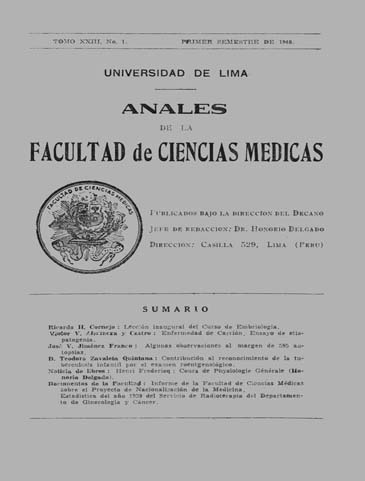Carrion's disease - pathogenesis Test
DOI:
https://doi.org/10.15381/anales.v23i1.9750Abstract
1. Is a Bartonella baciliformis rickettsioide germ - I endoteliotropo - and quite adapted to endocellular medium. In severe Bartonellosis. 2. Is intense colonization by endothelial cell system and the causal agent in parallel, therefore, proportional hemodifusión bloodstream by virus. 3. The causal relationship between CAV and Bartonella baciliformis Grave is difficult to explain if one ignores the action of toxic substances produced by the destruction of the virus. The reaction of the Host Cell progressively limits the number of parasites and work during this lag cell acute phase of the disease, clinically characterized by severe infectious, toxic state; pathologically degenerative lesions by particular anatomical hypertrophy, hyperplasia and myeloid mesenchymal reaction in the sector, the total number and breakdown of the blood picture appearance in the circulating blood of immature elements of all kinds. 4. Very often the acute illness is complicated by concurrent infection, usually caused by Salmonella, whose meaning is often decisive for the subject, which disfigures the anatomical table, modifies the body's response and aggravates infectious syndrome. 5. Bartonellosis Humana is an example of the immediate role the element plays in cell immunity. Anemia CARHTON, equivalents, warty eruption and latency are nothing but the expression of the existing current mode in virus-cell relationship.Downloads
Published
1940-07-15
Issue
Section
Trabajos originales
License
Copyright (c) 1940 Víctor V. Alzamora y Castro

This work is licensed under a Creative Commons Attribution-NonCommercial-ShareAlike 4.0 International License.
Those authors who have publications with this magazine accept the following terms:
- Authors will retain their copyrights and guarantee the journal the right of first publication of their work, which will be simultaneously subject to Creative Commons Attribution License that allows third parties to share the work as long as its author and its first publication this magazine are indicated.
- Authors may adopt other non-exclusive licensing agreements for the distribution of the version of the published work (eg, deposit it in an institutional electronic file or publish it in a monographic volume) provided that the initial publication in this magazine is indicated.
- Authors are allowed and recommended to disseminate their work over the Internet (eg: in institutional telematic archives or on their website) before and during the submission process, which It can produce interesting exchanges and increase quotes from the published work. (See El efecto del acceso abierto ).
How to Cite
1.
Alzamora y Castro VV. Carrion’s disease - pathogenesis Test. An Fac med [Internet]. 1940 Jul. 15 [cited 2024 Jul. 17];23(1):9-50. Available from: https://revistasinvestigacion.unmsm.edu.pe/index.php/anales/article/view/9750















